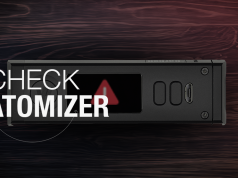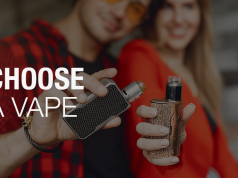First of all, what matters is that vaping is always less dangerous than smoking. Since 2015, the British Department of Health has estimated that electronic cigarettes are “at least 95% less harmful” than smoking. Even so, you can protect yourself even further. Choose e-liquids that only contain one flavour. If you make your own, try to limit how many additives you use. Change your coil regularly. You can also buy e-liquids made in France. These meet AFNOR standards, so they give you an additional guarantee of safety.
Switched to e-cigarettes or thinking about making the switch, leaving tobacco cigarettes behind you? You have made the right decision! You will reduce the risks generally associated with tobacco use by approximately 95% according to the UK Department of Health. However, to optimise this benefit for your health even further, you will need to use your e-cigarette correctly and choose e-liquids manufactured in line with professional standards. Below you will find some advice on making the right choice.
The lower the flavour content, the lower the risk
While the composition of e-liquids for e-cigarettes is well-known and controlled relatively well by manufacturers worldwide, some uncertainties remains in respect of the flavours used in formulas. Indeed, these food-grade flavours are used routinely in manufactured food, but their use for inhalation in vaping still raises many questions, given that the human airways do not have the same natural barriers as the digestive tract.
When these flavours are heated, they can for example produce aldehydes, volatile organic compounds derived from thermal degradation. The presence of aldehydes in e-cigarette vapour is nothing new, and the contents generally observed remain below the maximum exposure standards applicable to workplaces. Furthermore, tobacco smoke contains thousands of compounds that are hazardous for health, compared to a just a few, at very low concentrations, in vapour. On the other hand, e-cigarette studies are starting to identify some factors that are easy to control in e-liquid compositions, to help minimise the risk posed by vaping in comparison to tobacco further, and selective choice of flavours is one of these.
Some studies, the best-known of which are undoubtedly those by Maciej Goniewicz of the Roswell Park Cancer Institute in Buffalo (United States), have highlighted some flavours which might contribute to aldehyde production. For example, strawberry flavours can be a potential source of benzaldehyde in e-liquid and vapour. Similarly, some gourmet e-liquids frequently use diacetyl to give a buttery taste. This type of ingredient is potentially harmful for the body if the exposure and duration exceeds certain levels. Fortunately for us, the concentrations generally observed should not pose an immediate medical health risk, but if you are a vaper, you should naturally take heed.
The Maillard reaction
As a general rule, you need to understand the Maillard reaction to grasp these questions associated with the composition of an e-liquid. This interaction that takes place from a certain temperature (between 0 and 150°C) between amino acids and sugars present in foods (or e-liquids in our case) produces complex chemical mechanisms which can cause aldehyde or furan formation.
This Maillard reaction can be clearly visible to the naked eye when your resistance coil is clogged up, for example. It also provides cooked foods with their rich flavours, but in terms of vaping, the experience could be very different. The term “gunk coil” used in the vaping world, meaning a caramelised resistance coil, might be a good illustration of this phenomenon well-known to vapers, which often drives them to change their resistance coil.
Very sweet, gourmet e-liquids, or those imitating the flavour of tobacco, are for example known to foul resistance coils quickly. Additives or flavour enhancers (sucralose, ethyl-maltol, vanillin, monosodium glutamate, malic acid, etc.) potentially present in some manufactured e-liquids, or as ingredients sold separately for producing DIY liquids, could also boost this Maillard reaction and make the general composition of an e-liquid more complex.
So, while “vapology” has some distance to go in this area and uncertainty remains, it is nonetheless within everyone’s grasp to take these issues associated with flavours in e-liquids on-board, in order to possibly be able to vape more safely. As such, based on our experience, some principles can be established. We would like to stress that this information is informal, and in no way constitutes the opinion of a health professional, a chemist, or a professional e-liquid expert. Nevertheless, you will find our most basic advice below:
Precautionary principles for choosing your e-liquid
General precautionary principles
- Never vape if your e-cigarette e-liquid supply is defective, in order to prevent a “dry hit”.
- Observe the settings specified by the manufacturer if your device can be configured (Mod) and adapt your resistance value to these settings (ohm).
- It is preferable to increase your nicotine content to vape less, than to reduce it and increase your e-liquid consumption to make up for it.
- There are very few health benefits to be obtained from alternating tobacco cigarettes and e-cigarettes. It is preferable to stick to vaping, or even better, not smoke or vape at all!
- Direct-To-Lung (DTL) inhalation or cloud chasing (or power vaping) require heavy e-liquid consumption. Practise them with care.
Precautionary principles specific to e-liquids
- Opt for e-liquids manufactured by companies with highly qualified in-house staff (engineers, chemists, flavourists, etc.)
- Some manufacturing standards, including the renowned French Afnor standard, provide a non-negligible safety guarantee for the consumer.
- The higher the flavour content of an e-liquid, the greater the likelihood of the chemical reactions multiplying at high temperatures.
- A sweet e-liquid will be more likely to caramelise the resistance coil, and hence encourage potential volatile organic compound production.
- Change your resistance coil frequently (at least every two weeks in the event of daily use), especially when the flavour of your e-liquid has changed.
- Opt for e-liquids with simple (single flavour), rather than complex, flavours.
- If making your own e-liquid (DIY), try to minimise the flavour and additive concentration.
The right e-liquid
We hope that this information has helped you gain a better understanding of the complex, but nonetheless important, question of choosing an e-liquid. Bear in mind that e-cigarettes offer smokers a very substantial reduction in the risks associated with tobacco use, and if you are a novice vaper and have managed to give up cigarettes thanks to vaping, you can be very proud of yourself.
The right e-liquid, regardless of its composition, is an e-liquid that helps you forget tobacco cigarettes.








